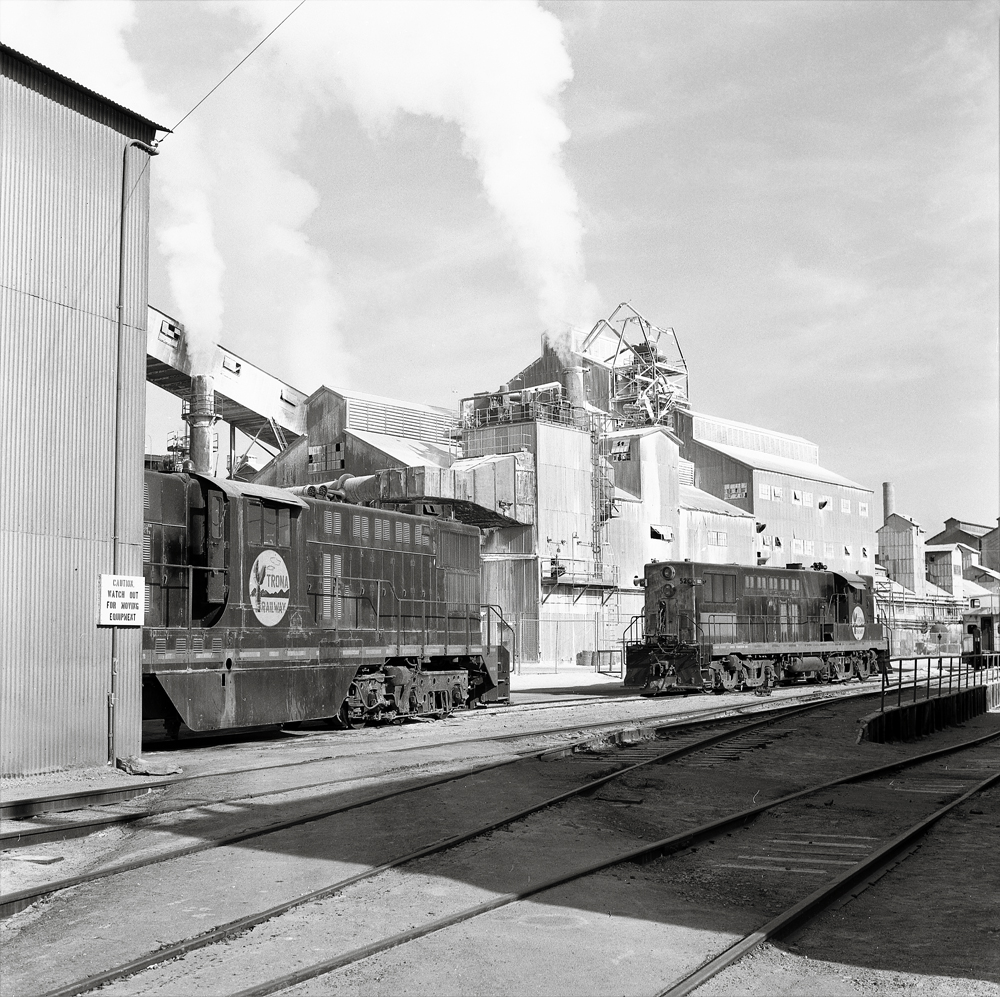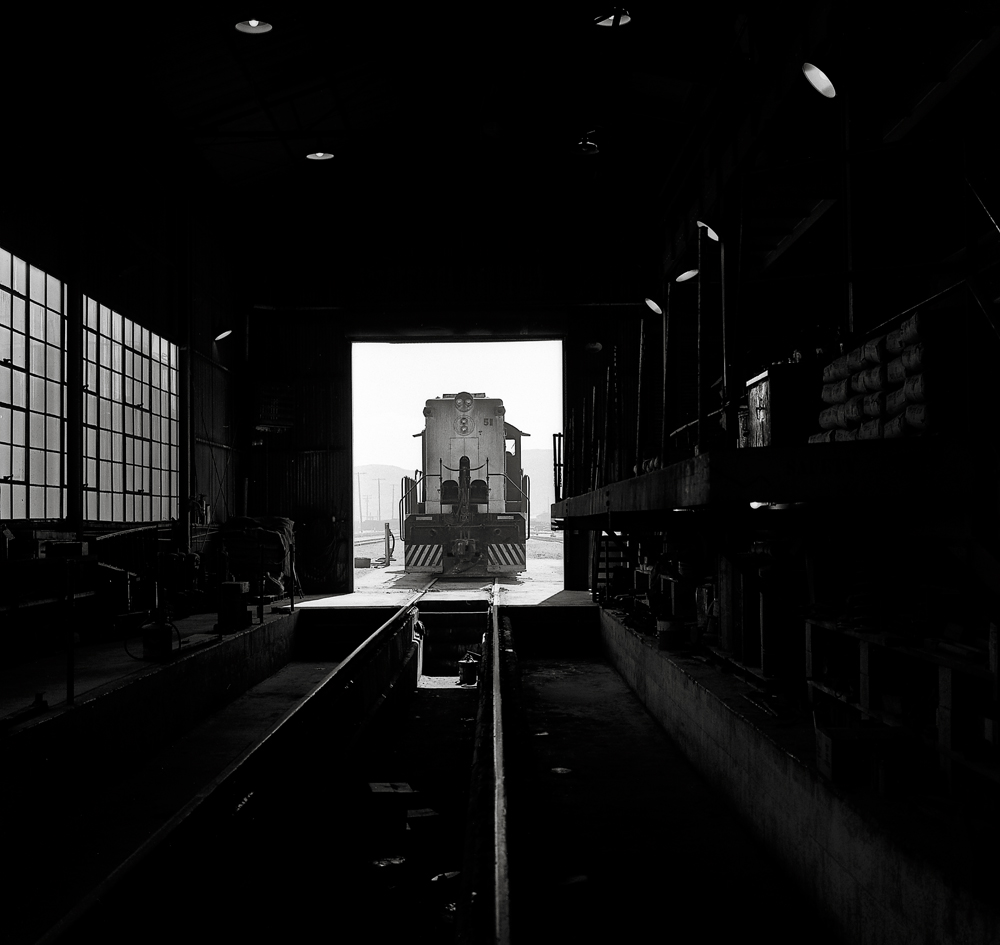Trona Railway

The California desert is different from the rest of the state. Remote, vast, and lonely, it is a world apart from the California coast or California north. Punctuated by cactus, brush, and fast-moving little creatures, it is seemingly geographically flat, yet is actually a series of undulating ups and downs that can create optical illusions and mirages.
Only the strongest survive here. It can be blazingly hot or bitterly cold, intensely sunny or violently stormy — sometimes all in the same day.
The Trona Railway, a creature of this desert, plods 30 miles between its namesake town and a remote interchange with Union Pacific (formerly Southern Pacific) at a wide spot in the road called Searles.
The unincorporated town of Trona, part of the Searles Valley, is not hard to find if you know where to look on a map. Locate State Highway 14 south of Lone Pine and find where Highway 178 intersects. Then follow your finger to the northeast and there it is, literally the middle of nowhere. Not exactly a vacation destination. Nonetheless Trona and the surrounding area provide important minerals for modern life.
For the newbies to the area, it can be a rude awakening. This is a California they don’t write about in the tourist pamphlets. Unless you like trains. Then the weather, the winds, and the false belief there is nothing here all becomes worth it.
It was one of those types of days I first encountered the railway’s two center-cab Baldwin diesels. Through scorching summers and bone-chilling winters, the slow-churning De La Vergne-engines took the worst Mother Nature could toss at them in stride.
Today, their EMD replacements follow in the same tradition, but the uniqueness of the motive power, once a drawing card for enthusiasts everywhere, is long gone. It’s still a hard railroad to operate, perhaps just not as unusual.
Fifty-one years ago
It was 1973 and the Trona Railway was new and unexplored territory for me. Along with Don Sims and Denis Dunning, I trekked 170 miles northeast from Los Angeles, past the railroad town of Mojave and into the seemingly unknown to Trona, a dusty, odorous unincorporated company town in the far reaches of San Bernardino County, Calif.
With a population of fewer than 2,000, it sat on the western edge of Searles Lake, itself a dry lakebed southwest of Death Valley. It’s named for the mineral that’s the reason for the railroad’s existence.
The trona harvested from the nearby dry lakebed is processed into soda ash or sodium carbonate, an important ingredient in the production of a variety of products ranging from textiles to toothpaste. That box of baking soda in your kitchen? Trona.
My first encounter with the Trona Baldwins — the railway rostered three road switchers and two center-cabs not including various plant switchers — took me back a little. Its road switchers were something I was used to; the Southern Pacific had plenty of almost identical units, in fact one of the Trona road switchers came secondhand from SP. But the center-cabs, combined with that utilitarian black with silver ends paint scheme they wore, created an aura all their own. Big slab-sided bruisers sitting on unforgiving trucks with giant cabs, adorned with slightly faded silver logos that included a black silhouette of mountains and a red and black palm tree.
We inquired about one of us getting a cab ride. I won. Sims would parallel the solid train of covered hoppers on his off-road motorcycle, camera strapped tight to his body. Dunning paced with a car.
Today’s train had Baldwin-Lima-Hamilton road switcher AS616 No. 53 on the point with the two DT-6-6-2000 center-cabs, Nos. 50 and 51, following obediently behind for a total of 6,400 hp to move 30-plus cars upgrade to the interchange. I was in the cab of the lead Baldwin when Engineer A.L. Anders, already made aware he had a rider today, arrived, greeted me with a perfunctory hello, sat down, checked to make sure everything was according to Hoyle, and began notching out the throttle.
The ride
I read somewhere that Baldwin’s long-wheelbase trucks made for a rough ride at higher speeds. I wouldn’t know, as we never topped 35 mph. Still, considering the track appeared to be in good shape, we bounced back and forth with great alacrity.
For Engineer Anders this was just another workday of many years at the throttle, and he accomplished his job with precision and professionalism. He didn’t have to worry about lineside signals, there were none. Nor were there any other trains on the line. But that didn’t mean, as we jostled along, he wasn’t constantly checking his speed, performing a very nice whistle blowing at grade crossings, looking for potential hazards including track conditions, inspecting his train whenever possible, and watching out for some guy chasing his train on a motorcycle.
He didn’t even mind his visitor bouncing around the cab, looking out the windows and taking photos without any attempt to hide his enthusiasm.
With his permission, I wandered back to the first center-cab to see what the train looked like from there. That cab was gigantic! You could seemingly hold a tennis match in there. It made for a great photo platform.
Heading back up front in the road switcher, I sat down in the vacant fireman’s seat and continued my bumpy but pleasant ride when Anders looked at me and said, “I’m going back to the second unit to go to the head. It’s better than the one in this unit. Be right back.”
I looked at him stunned. He’s going to leave me alone in the cab of a moving train. By myself! What?
My astonishment obviously registered on my face, so Anders added, “Don’t worry about it. There’s nothing else on the line and no animal of any size to hit. I’ll be back in a few minutes.”
I’m sure he was inwardly laughing all the way back to the center-cab. So, I watched the controls and checked the speedometer as if I knew what I was doing, looked out the window, and, probably, scanned the skies for flying saucers. But of course, nothing happened and when Anders returned, he smiled and said, “See!”
To Searles
A little over an hour later, a line of freight cars loomed in the distance. We were approaching Searles and the interchange with Southern Pacific. We paralleled the empty hoppers with our train, tied it down and transferred the Baldwins to a waiting set of inbound cars.
After an inspection, Anders and crew would head back home at an easy downhill gait. The cars they just dropped off would sit there until tomorrow when the SP local from Mojave would arrive to take them to civilization. The cars would return empty to start the process all over again.
I thanked Anders for the ride and alit from the Baldwin. Sims, who had photographed the Trona Railway before but never had a chance to ride it asked what I thought. My ear-to-ear grin said it all.














